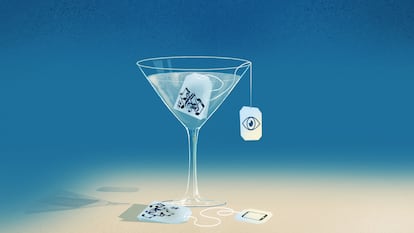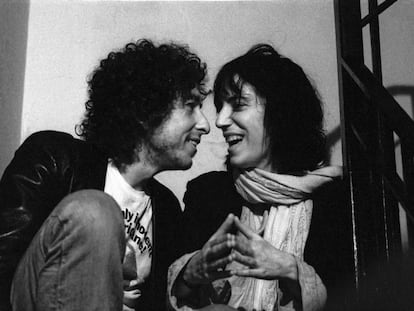Bob Dylan and coming of age
The artist, whose 1965 performance at the Newport Music Festival left his fans disappointed, ultimately propelled popular music into modern times. Some endings represent true beginnings

The French philosopher Gilles Deleuze argued that modern times did not begin at the same time everywhere and in all domains. In physics, the modern conception of time arose in the 17th century, but in philosophy it did not prevail until the following century, and the same revolution did not reach the cinema until the 20th century. In contrast to the action films, where the hero always managed to restore the disrupted order, a type of cinematographic narrative emerged. As in the films of Orson Welles and those of neorealism or the French New Wave, adversity is so great that no hero can put the world back together again as Hamlet did, albeit at the cost of his own life. This might be the reason why nothing seemed to happen in those stories: we may still remember the uproar of the spectators who attended the premiere of Jean-Luc Godard’s Alphaville in Madrid, who were lured by the reputation of its protagonist, Eddie Constantine, but encountered a plot that was impossible to decipher.
On top of this, I would contribute that, in the realm of popular music, the modern experience of time was ushered in on July 25, 1965, at the Newport Folk Music Festival in Newport, Rhode Island. The main star of the festival was undoubtedly Pete Seeger, who invented folk music along with Woody Guthrie and wrote a song entitled Turn, turn, turn, a sung version of Ecclesiastes chapter three. This was therefore the cyclical, seasonal time, the endless-cycle reminiscent of Elton John in The Lion King, which not only concerns the different “times” of the year, but also the division of the year into working days and holidays, and consequently encompasses the religious calendar. Ancient time, despite its eternal recurrence, abounds in misalignments, sometimes so cruel and catastrophic that the intervention of divine violence is required to return things to their place and ensure the regularity of the cycle. It is no wonder that Seeger is also the author of the song If I Had a Hammer (Hammer Song), the hammer of justice, which precisely symbolizes the wrath of the gods intervening to realign these occasional upheavals.
While Seeger was the auctoritas of the festival, the rising star was Bob Dylan, himself also fond of the biblical spirit, but who had been led astray by bad company (in August 1964, he had met up with the Beatles, who were touring America, in a room at the Delmonico Hotel in New York). That day, Dylan uncharacteristically took the stage accompanied by an electrified quartet and his performance of one song, Like a Rolling Stone, shattered everything folk music fans had come to expect from him. Besides the return to rock stagecraft — Pete Seeger stood up during the song demanding an axe to cut the wires of the amplifiers — what was important was that the song was painstakingly crafted to disappoint the audience who expected to hear a prophet, a herald of the voice of God or a guide who would lead them to salvation. Instead, they encountered a casually dressed musician who was abandoning them to the danger of an empty and infinite time from which all traces of divinity had disappeared. The crowd’s booing resounded.
In Martin Scorsese’s 2005 documentary on Dylan, No Direction Home, he ended the film with a performance of that same song on May 17, 1966, at the Free Trade Hall in Manchester, where a member of the audience could be heard shouting “Judas!” Initially, it seems a strange decision by Scorsese: why bring his artistic biography to an end with a performance from the musician when he was only 25 years old? Yet I would argue that it was a good idea. After that date, Dylan made some significant musical contributions of unquestionable merit, but that was his cardinal gift to the popular culture of his time. This not only because it actually helped popular music to step into modern times, but also because it was an unparalleled effort to bring a generation genuinely interested in civic progress to the age of majority — which is enough to warrant a Nobel Prize, although it’s a great shame that there isn’t one for music. This is a test that could be comparable to the convening of the referendum on Spain’s remaining in NATO by Felipe Gonzalez in 1986 and his defense of Spain’s entry into the Alliance - more than a few probably shouted “Judas!” at him for that. It was a chance for Spanish voters to transition to adulthood and coming of age is always painful and unpleasant, but absolutely necessary and it should be greatly welcomed.
Perhaps these endings (like the one in Scorsese’s film) are actually the true beginnings. We often speak of the humiliating dependence on kings and popes that artists have had to endure for centuries, forever captive to the order of the nobility or the high clergy to be able to survive. Therefore, they were forced to satisfy the needs, expectations and tastes of their masters. Yet the popular artist who becomes a huge success exposes himself or herself to subjection of the same family as that of the pre-modern artists. This was the case with Dylan, whose success was based on the assumption that he was conveying a religious, political and moral message of liberation to his listeners. Undoubtedly, an artist’s audience becomes captive to the idol it worships and is ready to applaud them freely, but not unconditionally. The artist-turned-star also falls captive to this audience, which they have to fuel with the message of salvation, which is expected of them. Dylan’s rebellion against this captivity marked popular music’s transition into modern times and, therefore, into the coming of age of those who have to free themselves from their guardians and learn to think for themselves. Naturally, this was one part of his audience, the most loyal to his message of salvation, who on that day abandoned Dylan for good. However, the part of the audience that continued going to watch Dylan, despite their disappointment, as well as the fans that subsequently began to listen to him, by that time comprised a truly modern audience of anonymous citizens who identified themselves with those past times. Perhaps that’s also why we should thank Dylan for his new tour’s refusal to indulge his fans with a greatest hits act and for obliging them to put away their cell phones as a prerequisite for them to genuinely become an adult audience.
Sign up for our weekly newsletter to get more English-language news coverage from EL PAÍS USA Edition
Tu suscripción se está usando en otro dispositivo
¿Quieres añadir otro usuario a tu suscripción?
Si continúas leyendo en este dispositivo, no se podrá leer en el otro.
FlechaTu suscripción se está usando en otro dispositivo y solo puedes acceder a EL PAÍS desde un dispositivo a la vez.
Si quieres compartir tu cuenta, cambia tu suscripción a la modalidad Premium, así podrás añadir otro usuario. Cada uno accederá con su propia cuenta de email, lo que os permitirá personalizar vuestra experiencia en EL PAÍS.
¿Tienes una suscripción de empresa? Accede aquí para contratar más cuentas.
En el caso de no saber quién está usando tu cuenta, te recomendamos cambiar tu contraseña aquí.
Si decides continuar compartiendo tu cuenta, este mensaje se mostrará en tu dispositivo y en el de la otra persona que está usando tu cuenta de forma indefinida, afectando a tu experiencia de lectura. Puedes consultar aquí los términos y condiciones de la suscripción digital.
More information
Archived In
Últimas noticias
Imelda Castro, the woman who wants to rule the cartel battleground of Sinaloa
The new victims of the Republican war on Obamacare: Millions hit by soaring health insurance premiums
A country divided on migrant rights: Some US states expand protections while others restrict them
Venezuela authorizes the release of another 87 political prisoners
Most viewed
- David King, chemist: ‘There are scientists studying how to cool the planet; nobody should stop these experiments from happening’
- Reinhard Genzel, Nobel laureate in physics: ‘One-minute videos will never give you the truth’
- Oona Chaplin: ‘I told James Cameron that I was living in a treehouse and starting a permaculture project with a friend’
- Sinaloa Cartel war is taking its toll on Los Chapitos
- The Interoceanic Train, the Mexican alternative to the Panama Canal










































